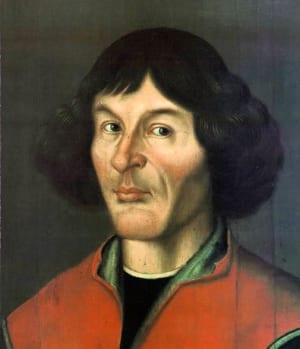
Nicolaus Copernicus is probably the second most famous astronomer in history (after Galileo). He is best known for being the first to propose that the Earth circles the sun, and not the other way around.
A Book
His theory ran into one problem, however. It was contrary both to conventional wisdom and Roman Catholic Church doctrine. So even though Copernicus had written his book on the subject, De revolutionibus orbium coelestium, he declined to publish it until he lay on his deathbed in 1543 to avoid eliciting unpleasant criticism from the Church.
It turns out that Copernicus was right – and not just about the solar system. De revolutionibus met with harsh criticism over the next few hundred years. Finally, in 1835, it was dropped from the Church’s Index of Prohibited Books, where it had been for more than two centuries.
Today, Copernicus is honored as a scientific titan. Since 1833, admirers have been able to pay homage to him in the Polish city of Warsaw. But they couldn’t visit his grave; until recently, no one could find his body.
A Body
It was known that Copernicus lies somewhere in the crypt of the cathedral in Frombork, Poland, where he lived for most of his life. But there are hundreds of other individuals interred there as well. Most of their tombs are unmarked, making identification extraordinarily difficult.
For decades archaeologists have been trying to narrow down which skeleton belonged to that of the 16th century astronomer. Recently, researchers in Poland and Sweden decided to turn to the field of ancient DNA analysis to solve this mystery. Their results are summarized in the Proceedings of the National Academy of Sciences: USA.
DNA Analysis
Prior to the DNA analysis, anthropologists had performed digital facial reconstruction on many of the crypt’s skulls, in hopes that one might bear a distinct resemblance to paintings of Copernicus. In 2004, Polish scientists found a candidate. But without more convincing evidence, they could not verify the skeleton’s identity.
This is where ancient DNA analysis comes in. Even though DNA begins degrading immediately following death, the genetic material is often preserved in the teeth for hundreds or thousands of years. Scientists studying ancient DNA (aDNA) usually focus on the type of DNA that has the greatest chance of surviving: mitochondrial DNA (mtDNA), which is passed exclusively from mother to children. The sheer abundance of mtDNA makes it much more likely to survive; each cell contains hundreds of copies.
Some Hair
Yet even after successfully extracting mtDNA from the skeleton’s teeth, one problem remained: the researchers had no DNA for comparison. They needed to find a DNA sample from Copernicus, or one of his descendants, in order to confirm these were in fact his remains. They found that sample in a seemingly unlikely place, housed inside a copy of the 16th century astronomy reference book Calendarium Romanum Magnum. This copy was of particular interest firstly because it was the personal copy of Copernicus himself, and secondly because there were hairs stuck within the binding that the scientists hoped contained his DNA. So the researchers analyzed DNA from the hairs, hoping that both they and the teeth had preserved enough DNA for analysis.
Their hopes were realized when both teeth and hair produced definitive mtDNA profiles that matched exactly. Both belonged to haplogroup H, a branch of the human mitochondrial genetic tree that is common across Europe. These results were verified independently at three laboratories, so the possibility of contamination is minimal. Because the two DNA samples were an exact match – with not even a single letter of DNA code out of place – the researchers conclude that the skeleton whose facial features so much resembled Copernicus had to be that of the famous astronomer.
But now that they knew his identity, these authors decided to run one more analysis on Copernicus’ remains. They were able to study a particular genetic marker, or SNP, found in the gene HERC2 that is believed to play a role in determining eye color. The authors found that Copernicus had a version of the SNP that predisposed people to a light eye color, such as blue or gray. This is quite intriguing, as almost all paintings of the astronomer show him with dark brown eyes.



